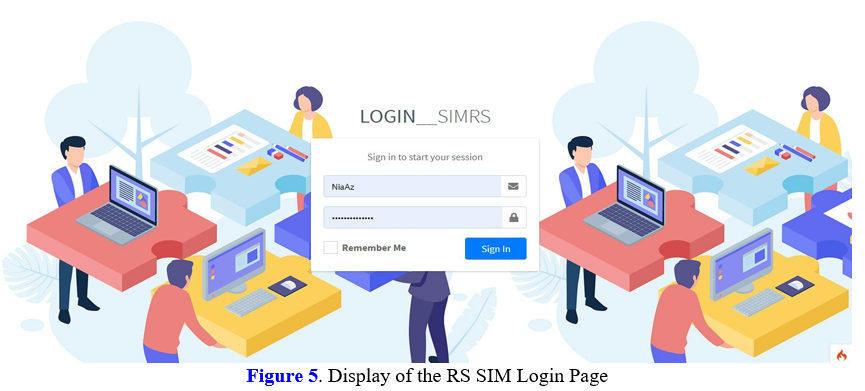Main Article Content
Abstract
Errors in prescribing and administering drugs are things that often occur in medicine, so in an effort to improve pharmaceutical performance, an evaluation and development of a SIM is carried out to support pharmaceutical services in hospitals. The aim of this research is to evaluate the Management Information System needs at RSI Ar-Rasyid Palembang and continue with the development of a design model. This research is descriptive research conducted through direct observation and documentation. The development of this research system uses a prototype method starting from needs analysis, system design and implementation of the EUCS (End User Computing Satisfaction) framework system, creating a system design using context diagrams, Data Flow Diagrams and Entity Relationship Data, the data analysis method used is qualitative analysis. The results of the research from direct observation on the completeness of the IFRS SIM show that the SIM at RSI Ar-Rasyid in pharmaceutical screening has been fulfilled, but in administrative screening and clinical screening it has not been fulfilled and the results of evaluation using a questionnaire distributed to pharmaceutical installation staff show an average the answer to each statement variable is satisfied. In making a draft design, there are suggestions that include clinical screening of prescriptions, it is hoped that this will help pharmacy installation staff in providing services to avoid medication errors. Based on system design, input design and output design, the patient prescription screening management information system design meets the criteria so it is ready to be implemented into the system.
Keywords
Article Details

This work is licensed under a Creative Commons Attribution-NonCommercial 4.0 International License.
References
- Advistasari, Y. D., Lutfan, & Pundjaningsih, D. (2015). Evaluasi Sistem Informasi Manajemen Farmasi Menggunakan D & M Is Success Model Untuk Mendukung Pengelolaan Obat Di RSUD Kota Semarang. Jurnal Manajemen Dan Pelayanan Farmasi, 5(4), 219–224. https://doi.org/https://doi.org/10.22146/jmpf.212
- Agrawal, A. (2009). Medication errors: prevention using information technology systems. British Journal Clinical Pharmacology, 67(6), 681–686. https://doi.org/https://doi.org/10.1111/j.1365-2125.2009.03427.x
- Andita, R., Rachmatullah, P., Akbar, S., Permata, S., & Mulyaningsih, S. (2016). Analisis dan Perancangan Sistem Informasi Pelayanan Obat di Apotek Generik. 2(1), 21–26.
- Firdaus, M., Fudholi, A., & Kristina, S. A. (2019). Evaluasi Sistem Informasi Manajemen Farmasi Di Rsi Sultan Agung Semarang Dalam Mendukung Standar Pelayanan Kefarmasian. Universitas Gadjah Mada.
- Hamidah, N. A., Salman, & Gethera, V. A. (2022). Profil Penggunaan Suplemen Ibu Hamil di Tiga Apotek yang Berada di Karawang. Jurnal Farmasi, 5(1), 62–72.
- Handiwidjojo, W., Informasi, S., & Sakit, R. (2009). Sistem informasi manajemen rumah sakit. Jurnal EKSIS, 02(02), 32–38.
- Jaelani, A. K., Sampurno, & Andani, T. M. (2015). Pengembangan Model Sistem Informasi Manajemen Skrining Development Model Management Information System Screening. Jurnal Manajemen Dan Pelayanan Farmasi, 5(4), 301–312.
- Kemenkes RI. (2016). Peraturan Menteri Kesehatan Republik Indonesia Nomor 72 Tahun 2016 Tentang Standar Pelayanan Kefarmasian Di Rumah Sakit. Retrieved from https://peraturan.bpk.go.id/Download/105431/Permenkes Nomor 72 Tahun 2016.pdf
- Kemenkes RI. (2004). Keputusan Menteri Kesehatan Republik Indonesia Nomor 1027/MENKES/SK/IX/2004 Tentang Standar Pelayanan Kefarmasian Di Apotek. Depkes RI.
- Kemenkes RI. (2008). Keputusan Menteri Kesehatan Republik Indonesia Nomor 129/Menkes/Sk/II/2008 Tentang Standar Pelayanan Minimal Rumah Sakit.
- Kemenkes RI. (2011). Peraturan Menteri Kesehatan Republik Indonesia Nomor 1691/MENKES/PER/VIII/2011 Tentang Keselamatan Pasien Rumah Sakit. Depkes RI.
- Kemenkes RI. (2013). Peraturan Menteri Kesehatan Republik Indonesia Nomor 82 Tahun 2013 Tentang Sistem Informasi Manajemen Rumah Sakit. Depkes RI.
- Khan, R.S., Saber, M. (2010). Design of a Hospital-Based Database System (A Case Study of BIRDEM). International Journal on Computer Science and Engineering, 02(08), 2616–2621.
- Megawati, F. D. P. S. (2017). Pengkajian Resep Secara Administratif Berdasarkan Peraturan Menteri Kesehatan Republik Indonesia Nomor 35 Tahun 2014 Pada Resep Dokter Spesialis Kandungan Di Apotek Sthira Dhipa. 3(1), 12–16.
- O’Brien, James, A. (2005). Pengantar Sistem Informasi Perseptif Bisnis dan Manajerial. Jakarta: Salemba.
- Panzera, A., Calligaris, L., Arnoldo, L., Londero, C., Quattrin, R., Troncon, M. G., & Brusaferro, S. (2009). Errors and omissions in hospital prescriptions: a survey of prescription writing in a hospital. BMC Clinical Pharmacology, 9, 9–9. https://doi.org/10.1186/1472-6904-9-9
- Putri Dianita Rifqia. (2017). Pengaruh Kualitas Pelayanan Kefarmasian terhadap Kepuasan, Kepercayaan, & Loyalitas Konsumen Apotek | Putri | Indonesian Journal for Health Sciences. Indonesian Journal for Health Sciences, 1(1), 23–29.
- Riswiyanti, A., Andayani, T., & Rahmawati, F. (2015). Desain Model Pengembangan Sistem Informasi Manajemen Skrining Resep Unit Farmasi Rawat Jalan. Universitas Gadjah Mada.
- Sandy Ria Apriliani. (2010). Studi Kelengkapan Resep Obat Untuk Pasien Anak Di Apotek Wilayang Kecamatan Kartasura Bulan Oktober-Desember 2008. Universitas Muhammadiyah Surakarta.
- Silbersthatz, A., Korht., S. (2005). Database System Concept. New York: McGraw Hill.
- Siti Ulfa Bugis. (2015). Kajian Administratif, Farmasetik dan Klinis Resep Pasien Rawat Jalan di Rumkital Dr. Mintohardjo pada Bulan Januari 2015. FKIK UIN Syarif Hidayatullah Jakarta.
- Vidia Sabrina Budihardjo. (2017). Faktor Perawat terhadap Kejadian Medication Administration Error di Instalasi Rawat Inap. Jurnal Administrasi Kesehatan Indonesia, 5(1), 52–61.
